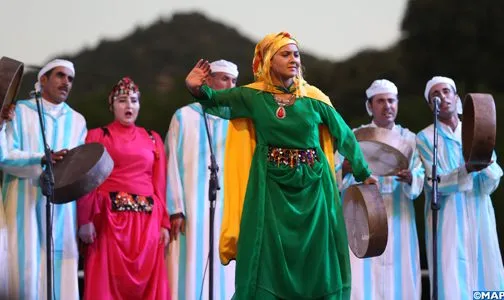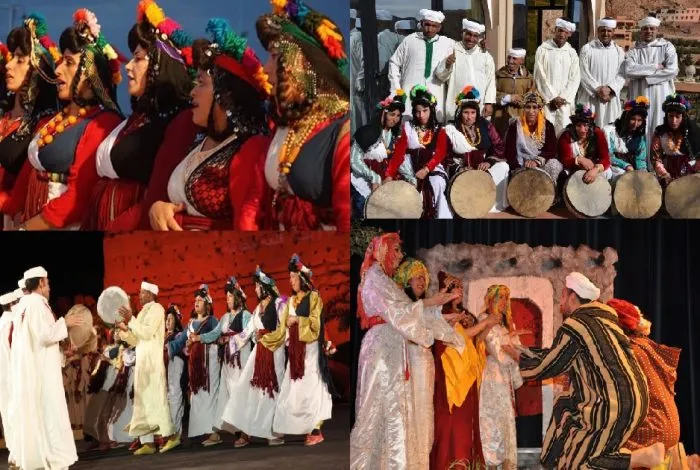The conclusion of the activities of the Ahidous Festival in its 21st session in Ain Al-Louh

Since Friday, August 5, the city of Ain al-Louh, affiliated to the Ifrane region, has lived on the rhythms of the activities of the National Festival of Ahidous in its 21st session, organized by the initiative of the Ministry of Youth, Culture and Communication - the Culture Sector - and the Taimat Association for the Arts of the Atlas, in partnership with the Council of the Fez-Meknes region, in which I performed performances A variety of the original heritage of the art of Ahidous from the various regions and destinations of the Kingdom (Khemesset, Sefrou, Figuig, Khenifra...).
In a statement to MAP, the Regional Director of Culture and Director of the National Festival of Ahidous, Fouadi Mahdaoui, said that the current edition of the festival devotes a new openness to the art of Ahidous, which creates an atmosphere of joy and pleasure to meet the practitioners of this intangible traditional heritage.

The 21st edition of the festival, organized in cooperation with the prefecture of the Ifrane region, the Ain al-Louh community, and the Ifrane regional council, combined the showy and festive aspect of the art of Ahidous, through performances by about 46 bands coming from different regions of the Kingdom over a period of three days, which represent different The colors and expressions of this authentic heritage art.
And included within the festival’s paragraphs, a moment of loyalty and recognition by honoring a group of the most prominent figures in the art of Ahidous and its artists, in appreciation of their distinguished artistic career and their well-recognized giving, and the abundant effort they made in preserving it, preserving it, ensuring its continuity, and introducing it to the nobility of its artistic and human messages. In addition to organizing a scientific symposium, within the framework of parallel activities, on the topic “The Art of Ahidous: Artistic and Scenic Memory,” with the participation of a group of researchers and specialists in the field.
Ahidous is considered a type of art that combines traditional Amazigh music and dance, and is spread in the mountains of Morocco, the Middle Atlas mountains, in addition to southeastern Morocco; Especially in Jebel Soghro, and it is performed by men and women who line up in the form of a line or a circle, and Ahidous is also performed at weddings as a form of entertainment

Ahidous is considered a type of art that combines traditional Amazigh music and dance, and is spread in the mountains of Morocco, the Middle Atlas mountains, in addition to southeastern Morocco; Especially in Jebel Soghro, and it is performed by men and women who line up in the form of a line or a circle, and Ahidous is also performed at weddings as a form of entertainment.
Ahidous is considered a type of art that combines traditional Amazigh music and dance, and is spread in the mountains of Morocco, the Middle Atlas mountains, in addition to southeastern Morocco; Especially in Jebel Soghro, and it is performed by men and women who line up in the form of a line or a circle, and Ahidous is also performed at weddings as a form of entertainment.
In this regard, it is noteworthy that this lyrical art appeared in the Middle Atlas region many centuries ago. It is the art that has been associated since its inception in the natural and geographical milieu of the Middle Atlas man, where forests, water, forests, mountains, and resorts rich in greenery and sources. This art, which appeared for the first time in its circular shape, consisted of women and men alike, and in its semicircular form, was an expression of the joys, delights, and collective joys that accompany man’s revival of his mountainous and agricultural life in the plains and borders of the Middle Atlas.
Ahidous is usually known for the dances and collective physical expressions that we find sometimes even in regions whose inhabitants do not speak Amazigh, but researchers, interested people, and scholars agree that his original homeland is the Middle Atlas, the natural and geographical field in which the components of poetry, singing, dance, and rhythm are complete.
Source : sites Internet

